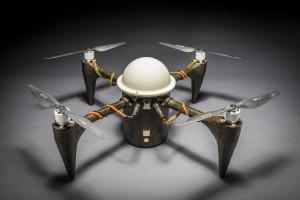 Drones are becoming more and more flexible and capable of things that were unheard of just a few years ago. We’re seeing 3D printing drones and firefighting drones. Futurists have predicted the possible existence of drones large enough to move houses in the next century. We’ve seen submersible drones, but until now, we haven’t seen anything quite like the unmanned aerial vehicle (UAV) that researchers at the Johns Hopkins Applied Physics Laboratory (APL) have developed. The Corrosion Resistant Aerial Covert Unmanned Nautical System (aka CRACUNS) is a submersible drone that can lurk underwater for as long as two months, then launch into the air to carry out a variety of missions.
Drones are becoming more and more flexible and capable of things that were unheard of just a few years ago. We’re seeing 3D printing drones and firefighting drones. Futurists have predicted the possible existence of drones large enough to move houses in the next century. We’ve seen submersible drones, but until now, we haven’t seen anything quite like the unmanned aerial vehicle (UAV) that researchers at the Johns Hopkins Applied Physics Laboratory (APL) have developed. The Corrosion Resistant Aerial Covert Unmanned Nautical System (aka CRACUNS) is a submersible drone that can lurk underwater for as long as two months, then launch into the air to carry out a variety of missions.
“Engineers at APL have long worked on both Navy submarine systems and autonomous UAVs,” said Jason Stipes of APL’s Sea Control Mission Area, project manager for CRACUNS. “In response to evolving sponsor challenges, we were inspired to develop a vehicle that could operate both underwater and in the air.”
The 3D printed drone is lightweight but tough, capable of withstanding water pressure several hundred feet below the surface without requiring structural metal parts or machined surfaces. It can be docked either at an underwater station or on an unmanned submarine and controlled remotely; once its controllers have released the CRACUNS, it shoots to the surface, bobs for a moment, then takes off into the air on its mysterious mission. The drone’s developers haven’t said what exactly those missions may be, but have noted that its resistance harsh conditions and its “payload flexibility” make it ideal for a wide variety of applications.
 CRACUNS can operate effectively in either fresh or salt water; its sensitive components are sealed safely in a waterproof, pressure-resistant 3D printed vessel. Protective coatings were applied to the exposed motors, at which point the drone was submerged in salt water to test its resilience. After two months, the CRACUNS rose from the deep with no sign of corrosion or other damage, operating as effectively as it had before it was submerged.
CRACUNS can operate effectively in either fresh or salt water; its sensitive components are sealed safely in a waterproof, pressure-resistant 3D printed vessel. Protective coatings were applied to the exposed motors, at which point the drone was submerged in salt water to test its resilience. After two months, the CRACUNS rose from the deep with no sign of corrosion or other damage, operating as effectively as it had before it was submerged.
“CRACUNS successfully demonstrated a new way of thinking about the fabrication and use of unmanned systems,” said Richard Hooks, an aerospace and mechanical engineer at APL, responsible for the 3D printed design of the drone.
3D printing the drone had a lot of advantages; besides the light weight and sturdy waterproof structure, a 3D printed drone is also much cheaper to manufacture, meaning that hordes of CRACUNS can be created and deployed for high-risk missions. If a drone is damaged or destroyed, it’s easy and inexpensive to replace it, which gives its operators a lot more flexibility when it comes to its uses.
 APL’s Force Projection Sector developed the quadcopter along with fabrication experts from the the Research and Exploratory Development Department. The APL has eleven specific “mission areas,” all operating in the national security and defense sector. The Sea Control Mission Area, which was responsible for CRACUNS’ development, mainly supports the US Navy.
APL’s Force Projection Sector developed the quadcopter along with fabrication experts from the the Research and Exploratory Development Department. The APL has eleven specific “mission areas,” all operating in the national security and defense sector. The Sea Control Mission Area, which was responsible for CRACUNS’ development, mainly supports the US Navy.
“APL’s culture of innovation and mission-ready solutions continues to deliver success for our sponsors,” said Sea Control Mission Area Executive Christopher Watkins.
While those particular sponsors weren’t named, it’s pretty clear that CRACUNS is intended to play a significant role in naval operations. How soon it will go into operation also remains to be seen, but I’m betting it won’t be long considering how successful it has been in testing. What do you think of the purpose this technology is playing here? Discuss in the 3D Printed Drones forum over at 3DPB.com.
Subscribe to Our Email Newsletter
Stay up-to-date on all the latest news from the 3D printing industry and receive information and offers from third party vendors.
You May Also Like
3D Printing News Briefs, April 13, 2024: Robotics, Orthotics, & Hypersonics
In 3D Printing News Briefs today, we’re focusing first on robotics, as Carnegie Mellon University’s new Robotics Innovation Center will house several community outreach programs, and Ugogo3D is now working...
Rail Giant Alstom Saves $15M with 3D Printing Automation Software 3D Spark
3D Spark has entered into a three-year deal with the rail giant Alstom. Alstom, a transport behemoth with annual revenues of $16 billion, specializes in the manufacture of trains, trams,...
Meltio Expands Global Reach with New Partnerships in the Americas and Europe
Spanish 3D printing manufacturer Meltio has expanded its sales network across the globe. With the addition of three new partners in the United States, Brazil, Argentina, and Italy, Meltio aims...
3D Printing Webinar and Event Roundup: April 7, 2024
Webinars and events in the 3D printing industry are picking back up this week! Sea-Air-Space is coming to Maryland, and SAE International is sponsoring a 3D Systems webinar about 3D...
































